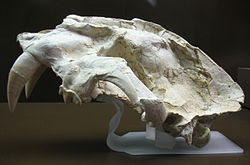Machairodus
|
Machairodus Temporal range: Late Miocene to the |
|
|---|---|
 |
|
| M. aphanistus skull | |
| Scientific classification | |
| Kingdom: | Animalia |
| Phylum: | Chordata |
| Class: | Mammalia |
| Order: | Carnivora |
| Family: | Felidae |
| Subfamily: | †Machairodontinae |
| Tribe: | †Machairodontini |
| Genus: |
†Machairodus Kaup, 1833 |
| Type species | |
|
†Machairodus aphanistus Kaup, 1832 |
|
| Species | |
|
|
Machairodus is a genus of large machairodontine saber-toothed cats that lived in Europe, Asia, Africa and North America from the late Miocene to the . It is the animal from which the family Machairodontidae gets its name and has since become a wastebasket taxon over the years as many genera of sabertooth cat have been and are still occasionally lumped into it.
Machairodus was first named in 1832, by German Naturalist J. J. Kaup. Though its remains were known since 1824, it was believed by George Cuvier that the fossils had come from a species of bear, which he called "Ursus cultridens" (known today as Megantereon) based on composite sample of teeth from different countries, species and geologic ages, leading to what would become a long series of complications. Kaup however, recognized the teeth as those of felids and promptly reclassified the existing specimens as Machairodus, including M. cultridens in it. The name quickly gained acceptance and by the end of the 19th Century, many species of felid or related feliform (such as nimravids) were lumped into the genus Machairodus, including but not limited to Sansanosmilus, Megantereon, Paramachairodus, Amphimachairodus, Nimravides, and Homotherium among others. This would eventually turn Machairodus into something of a wastebasket taxon, which would be rectified with the discoveries of more complete skeletons of other machairodonts.
Macharodus was similar in size to a modern lion, standing about 1 meter at the shoulder. The species once referred to Machairodus coloradensis was apparently significantly larger, about 1.2 m at the shoulder, according to skeletal and life reconstructions. If accurate, this would have made M. coloradensis one of the largest felids. However M. coloradensis, along with M. kurteni and M. giganteus, has been reassigned to the genus Amphimachairodus and by extent, the Homotherini based on both morphology and its time of appearance in North America.Nimravides catacopsis also has been separated from Machairodus, as the two are too different in regards to autapomorphies to be synonymous. However, the species Machairodus horribilis, which stands as the largest known species of the genus, is comparable in size to the equally large and much later Smilodon, to which it has been compared, weighing in at around 404.6 kg (892 lb.). Its skull, measuring upwards of 16 inches in length, is the largest known skull for any machairodont.
...
Wikipedia
